Stunning Socialist-era Architecture : The Brutalism of Zagreb, Croatia
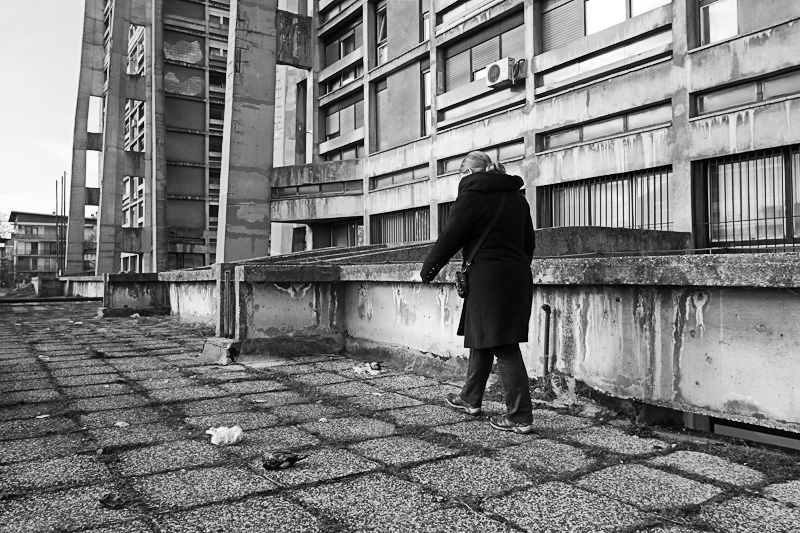
Exploring Communist-era or Socialist-era architecture isn’t on the standard bucket list of most European tourists. The historic old-worldliness of European cities is legendary, indeed, most tourists crave a labyrinth of winding cobble-stoned streets, lined with richly decorated centuries-old buildings – the typical scenes in the “old town” at the heart of most European cities. However, there is a often a much more brutal, and somewhat unknown side to these same locations.
On the outside of the old town, there’s a lesser travelled area of these cities. Here, are the many “new” Communist-era or Socialist-era planned districts and suburbs. Built around the historic downtown cores, the often populous areas are especially common in post-communist post-Soviet ex-USSR, and the formerly socialist Yugoslavian nations.
Zagreb, the capital city of Croatia, is no exception to this practice. Commencing on the edges of Zagreb and bleeding into Novi Zagreb is a hotbed of Socialist-era architecture. Only a few minutes from downtown Zagreb the ornate, picturesque gives way to a collection of starkly brutal and modernist architecture along a network of wide roads. It’s truly mid-century socialist city-planning on a grand scale.
Leaving the center of Zagreb, and crossing the Sava River to Novi Zagreb, is like entering another world. A beautiful, dream-like, concrete-filled world. Paradoxically familiar, normally unexplored, from the past and yet from the future, I have found that places like Novi Zagreb create a strange nostalgia for a world I have never known.
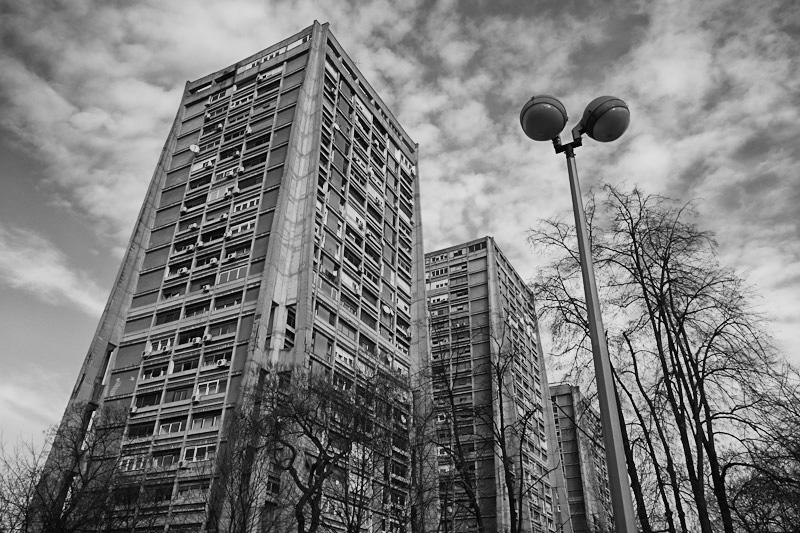
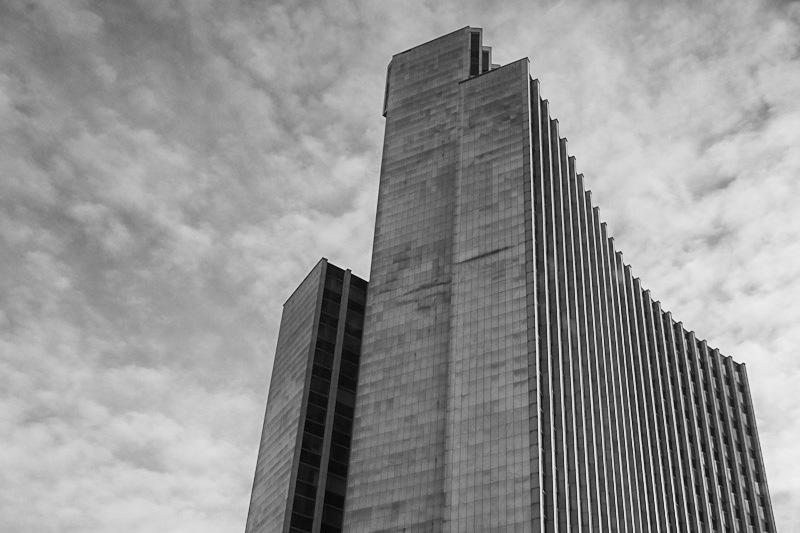
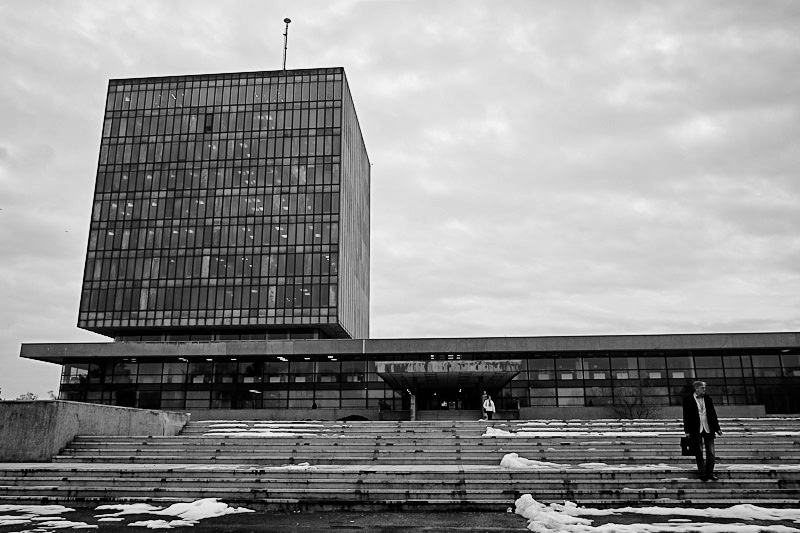
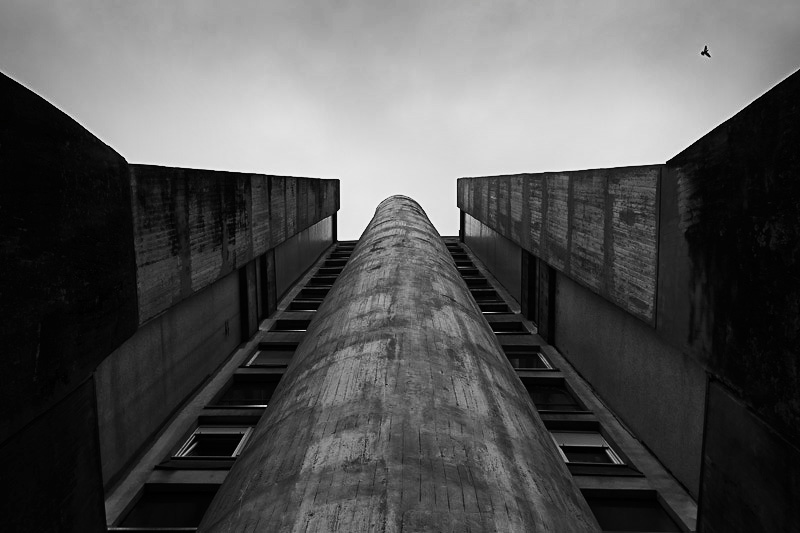
Novi Zagreb, like many of the planned mid-20th century European cities, was built in the battle scarred shadow of the Second World War. Using a familiar architectural blue print, most buildings can be categorised as perfect evil-genius lair, amazing location for super villain head quarters, or what would broadly and flatteringly be referred to as 1970’s communist chic. Some buildings impress by design, others, by sheer immensity and brutality.
Concrete is the material of choice in Novi Zagreb. Although much of the communist-era architecture is now decayed due to a lack of maintenance, giving a purely dystopian feeling, keep in mind that when first constructed these buildings and the streets that house them were pure optimism-fueled utopia. The architecture and city planning of Novi Zagreb incorporates futuristic mixed-use building designs, surrounded by extensive park lands and efficient public transport networks.
Seemingly audacious planned cities like Novi Zagreb rejected what would soon become known as un-environmental urban sprawl that most Western cities were following. Think of Novi Zagreb as your typical American suburbia, on steroids. The promised land in the style of the mid-twentieth century style. Geometric, efficient, and admirably designed with people in mind.
Communist Architecture Redux – Coming to a City Near You?
Around the world, a revival of brutal and mid-century architecture has taken place – much inspired by the communist-era architecture and city planning of mid-century Europe. From the new Scottish Parliament building, to the planned cities of Korea, city planners and architects are looking at these examples not only for design inspiration, but for solutions to the issues many modern cities grapple with. Lack of viable public transportation, low population density, and horrendously unsustainable suburban sprawl being the number one targets. Although, a primary motivator for the construction of these cities would have simply been to rapidly provide housing for people – in the aftermath of the most devastating war the world had ever seen.
There are many aspects of cities like Novi Zagreb that demand further exploration and explanation, and I hope that people with more expertise than myself would leave relevant links in the comments below.
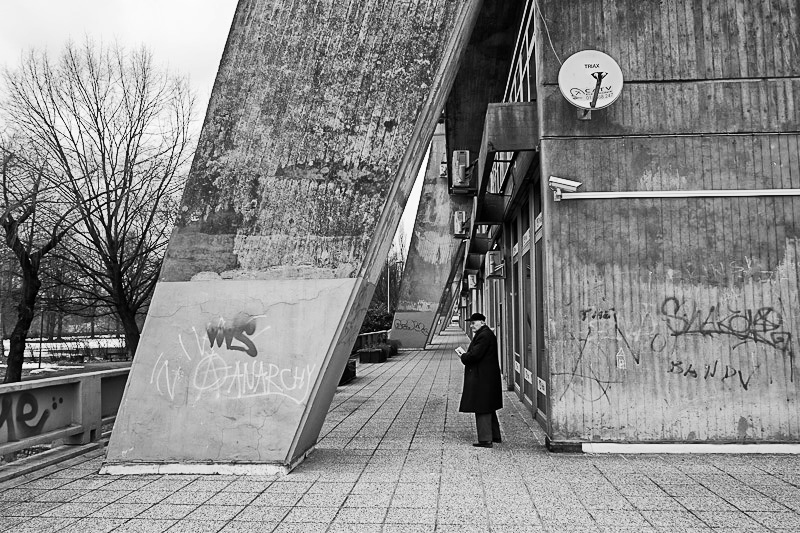
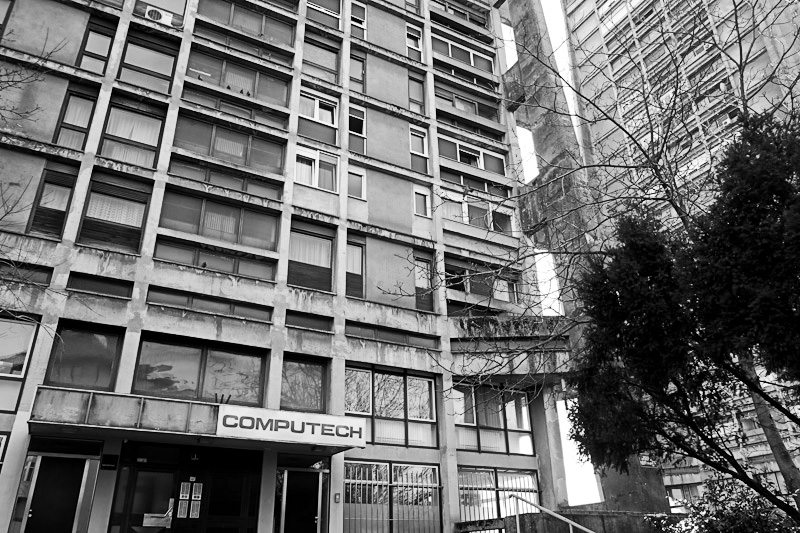
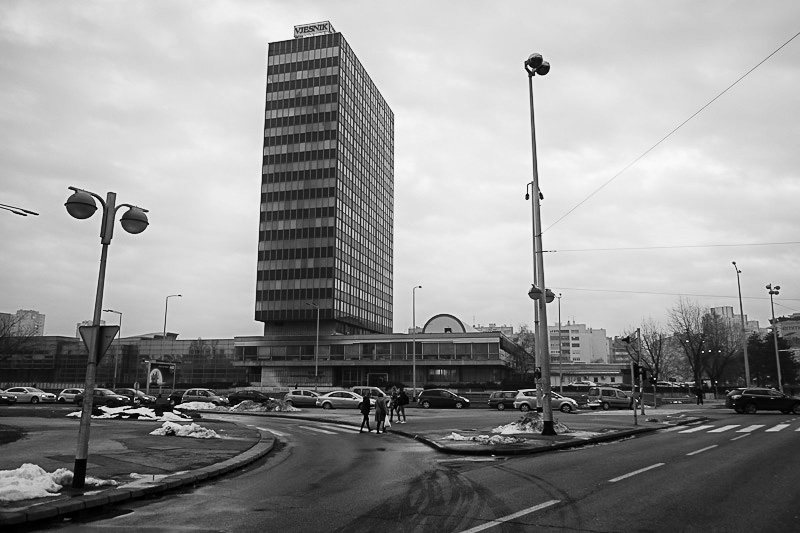
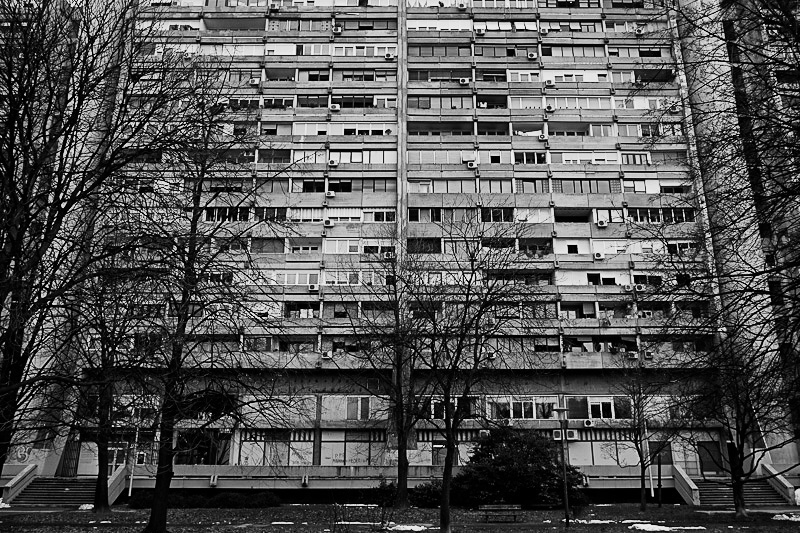
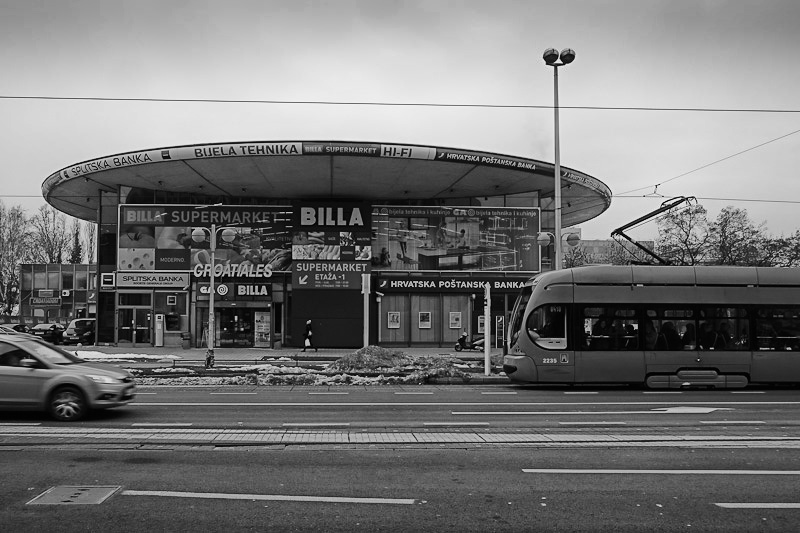
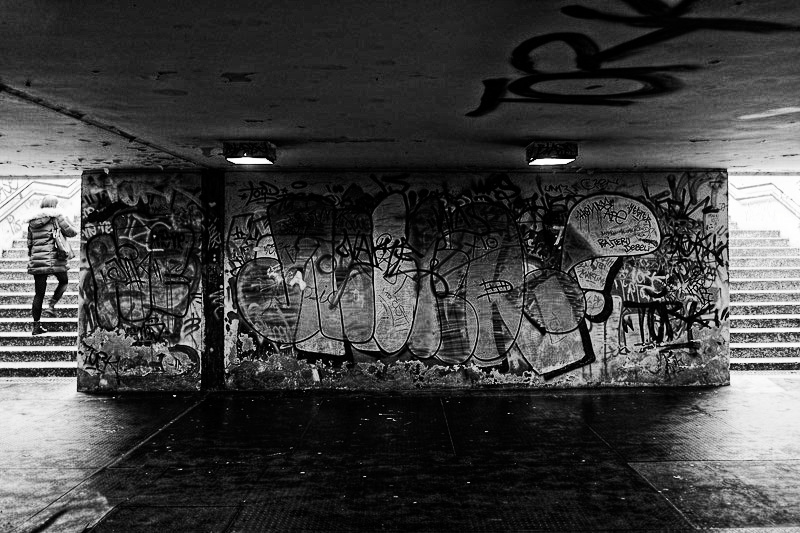
Ironically, adjectives for communist-era or Socialist-era architecture range from gray and soul-less, to futuristic and expressive. Either way, this style can usually be described as heavy – cubic meters are the name of the game here. Masses of raw mid-century concrete and steel in geometrical formations are one of the main attractions in the former Yugoslavian nations, in my humble opinion.
Communist Architecture – Will It Go the Same Way as Communism?
Part of my reasoning to visit the Balkans this year, is due to the absolute certainty I have that many of these stunning buildings will not survive much longer. Despite some fantastic examples of renovation and re-purposing, the future of most of these unique examples of architecture is far from certain. Many, not all, were not built to last in the first place, and maintenance is lacking – contributing to further decline. Although these are often technologically advanced structures, without regular maintenance they simply will not last.
Public opinion is certainly not on the side of the aesthetic “qualities” of these structures, and none are old enough to typically warrant heritage protection. For example, in nearby Bratislava, Slovakia – the elegant modernist Hotel Kyjev is slated for demolition. I stayed at the Hotel recently, and was sad to hear that Kyjev has now closed its doors, with the new owners wishing to redevelop (destroy) the entire city block. There are some exceptions, but in general, this era of architecture does not attract enough supporters in the right places to be sure about the future prospects.
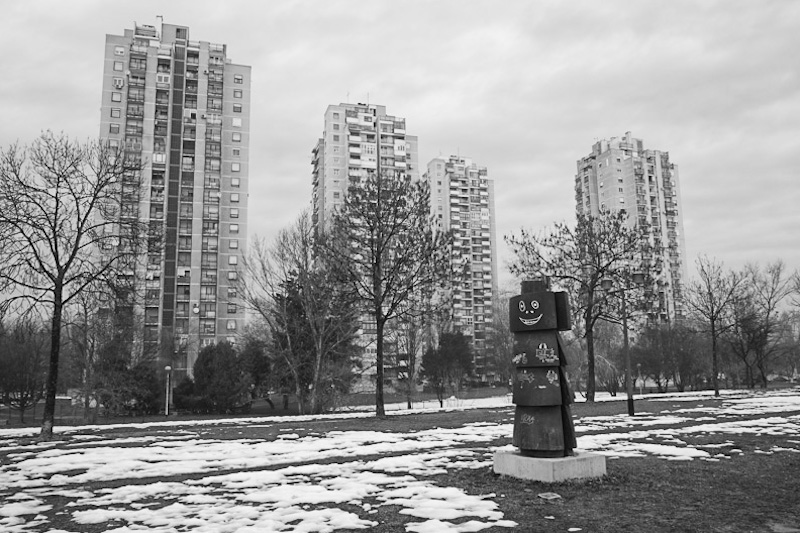
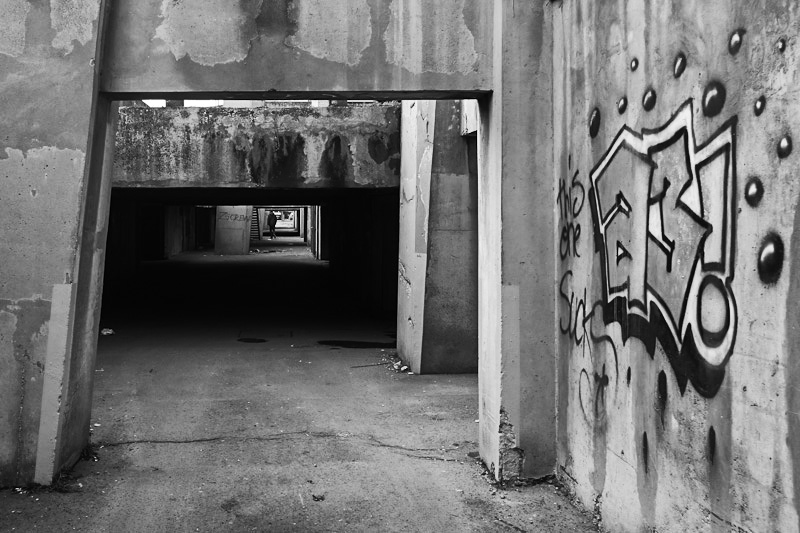
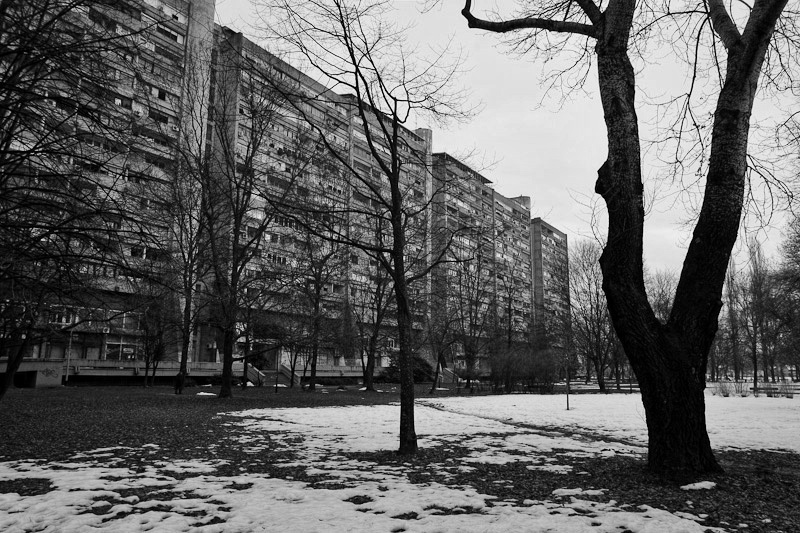
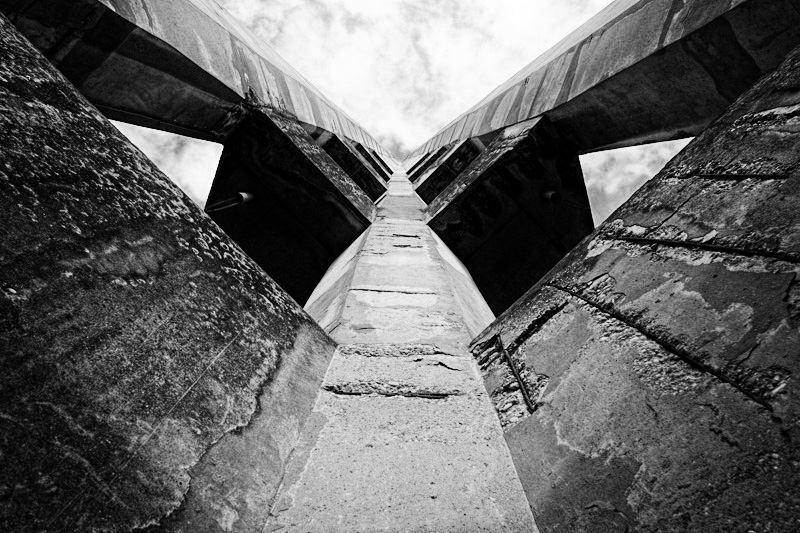
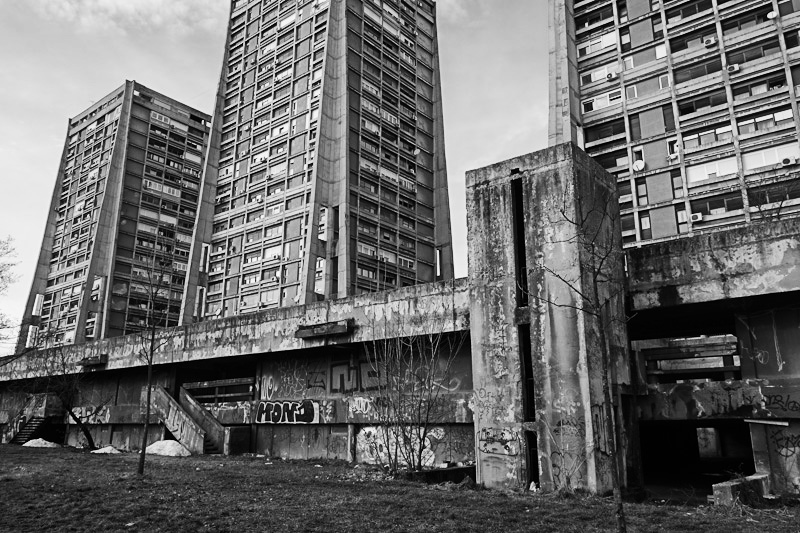
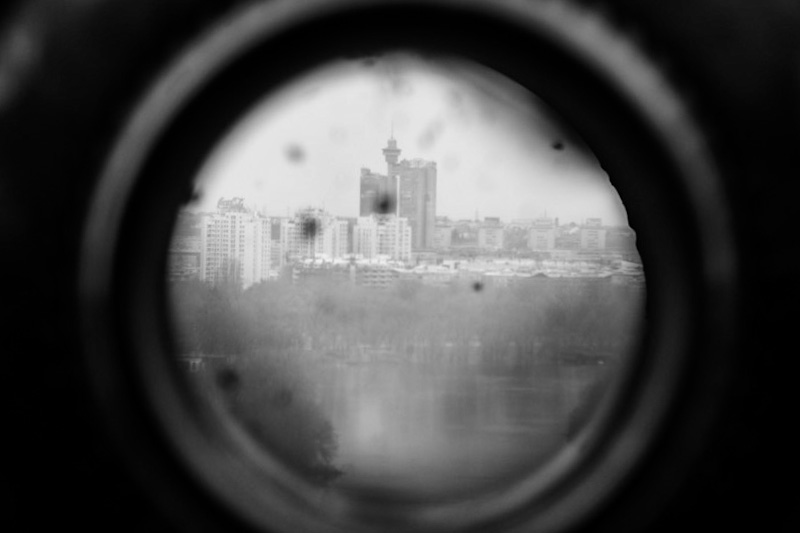
click to see an interactive map showing the location of this article
Continuing my grand tour of the Balkans – this week I find myself in Belgrade, Serbia. Replete with its own Socialist-era”new city” of Novi Beograd, Belgrade just may be considered ground zero of planned former Yugoslavian cities. I’ve already photographed some absolutely spectacular examples of Socialist modernism architecture. Novi Zagreb was just the entree, for fans of this style of end-of-the-world architecture, the main course of Novi Beograd will blow your red socks off. Stay tuned for the next installment.
There is so much more to show and discuss when it comes to communist architecture and city planning. One aspect I can’t comment on – what is it like to live in these buildings? I would love to read stories from anyone who lives or works in buildings of this nature.
Communist architecture may not be your typical tourist attraction, but I can assure you there is a growing legion of communist/socialist/brutal/modernist architecture fans out there.
And I’m well and truly one of them.
Nate
PS, I’ve previously covered the amazing examples of “communist” architecture found in Bratislava, and Zizkov Tower in Prague on Yomadic. In anticipation of some of the comments I may receive about this article – I would like to state that I understand not all of the architects would identify as being “socialist”, “communist”, “Soviet”, or being from “Yugoslavia”. I use these terms simply to identify an era in history, and mostly to assist readers in finding this article. I do welcome any comments anyone has, there is no censorship here.
* update: as correctly pointed out by an informed comment, to be clear – many of these buildings are technically located in “Zagreb” not “Novi Zagreb”. However, all of the buildings are well outside the “core” of old Zagreb, and indeed, are within moments of where Novi Zagreb officially commences. I have removed the word “Novi” from the article title.
* update, July 2018 : this week alone, more than 60,000 people have read this article. Over the lifespan of this page, there are sure to be more than one million views. One of the photos has now appeared in publication, another has won me a prize. I truly love this architecture, and I’m glad to know the popularity is finally increasing.
FINALLY – while I’m here – as at July 2018, I have been travelling continously for six years, living each day from my backpack. Not one day in six years have I ever unpacked my bag and stopped. I’ve developed a true fondness for Eastern Europe and former Yugoslavia, and have travelled through, and returned to, most countries in the region, regularly.

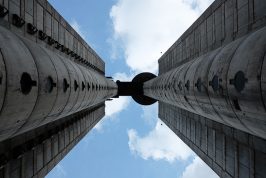

Great update as always. Did you mean to get the bird in the top right of the “Super Adrija” photo? It really adds something to the photo. I love these new towns and the old towns. Very annul that the planners didn’t knock down the old town to build the new town, as happened in other places in the world *ahem Perth ahem*.
Cheers mate… yes, I had the “Perth discussion” with Phillipa yesterday. We are in Belgrade now, and despite it being a very old city – most of the old town was only built during the 1800’s, so in a strange way it’s not so much older than many “new world” cities. Perth could have retained it’s “old town”, and built a “new town” nearby, when land was abundant. Another lesson we could have learned from the communist era town planners and architects.
I have lived in one of those buildings in Novi Zagreb for 30 years. It has some kind of Nostalgia…now that I live in Canada it is something I like to remember for sure. Lots of kids in my time ( mid 80’s), lots of parks between those concrete blocks and in wich we had soo much fun….
I loved the way the black and white photos captured these buildings. I lived in eastern Croatia and the loved wandering neighborhoods taking photos of the decaying symbolic architecture. Really enjoyed your perspective, makes me want to walk around there. Looking forward to some Beograd pictures, the hotel I stayed in there was like stepping in a time machine right back to communist era!
oooh… which Hotel was it Crystal? Would love to check it out!
I believe it was called Hotel Slavija. Staying there was unplanned-the flights were cancelled last minute and the airline put us there; I’m sure they have more upscale rooms than we were in but WOW!
Our rooms were OlD, tiles falling off bathroom, ancient appliances & furniture. It was literally like stepping into the 70’s, even a yellow/tan Rotary phone! Its near The Cathedral of Saint Sava (largest Orthodox Church in Balkans) Vračar neighborhood right at a huge roundabout. http://www.slavijahotel.com/slavijahotel/slavijaab/indexabe.php
Also if you need a cafe to relax or work you can have excellent coffee and free wifi with unique modern decor check out San Francisco Coffee House Beograd. http://www.sfch.rs/ not too far from the Tesla museum!
Looking forward to your photos!
Thanks Crystal – what a coincidence, I walked past Saint Sava, and then Hotel Slavija just an hour ago. I was with some Belgrade locals, and they described the hotel as “the worst hotel in the world”..and that it was famous, as the restaurant on the corner is where a Serbian General was assassinated… I have to check this place out now!
Thanks for the Coffee House recommendation, will stop for a rest when I’m nearby.
For anyone interested in this kind of architecture, you can take a look at Yugoslav WWII monuments
http://twistedsifter.com/2011/05/23-fascinating-and-forgotten-monuments-from-yugoslavia/
In fact, these kind of architecture was not strictly communist. That generation of Yugoslav architects were inspired by Le Corbusier and French “brutalist” movement, as well as Bauhaus functionalism. But, Yugoslav Communist Party was supporting experiments, as it was a idology of “new world”. On the other side, they wanted to differ from the Soviet block after the confrotation with Stalin
And, of course, congratulations on another great reportage!
Thanks Jadran, and cheers for the link to the Yugoslavian era monuments.
The Brutalism of New Zagreb? I see only one photo from Novi Zagreb (!?) – Superandrija. I can not believe you missed Mamutica?
wiki -“Mamutica is the largest building (by volume) in Zagreb and Croatia, as well as one of the largest apartment blocks in Europe.”
NZg is not so brutal at all, there are lots of parks and playgrounds, and new infrastructure. In last 15 years price of NZG square meter is above Zagreb average, so people really enjoy living here.
And yes, photos are really brutal, but only because of B/W filter and winter time. You may consider using colors for reality report, and filters for art photo.
Regards
Hi Nikola, I will head to Mamutica next time. It was on my list, as were many others, but time was against me. “Brutal” refers to the “Brutalist” style of architecture – linear, fortress-like and block-ish, usually constructed of concrete. I mentioned the “extensive park lands”, perhaps you missed it in the article.
You are correct in that many of these buildings are along the border of Novi Zagreb, however, the article is a presentation not only of the communist architecture – but of communist city planning. In this regard, Novi Zagreb is the focus.
The photos look remarkably similar in black and white or colour. The buildings are grey, the ground is white, the sky is grey, and the dead pigeon with it’s head ripped off surrounded by garbage, remains a dead pigeon with it’s head ripped off surrounded by garbage.
Thanks for your suggestion with regards to my photography – but I see my photos as art, not reality.
However – my reality, is real.
Love your perspective on this type of architecture and how you find the beauty in it, where most just find the ugly. They are an interesting subject to be sure and lend themselves to b&w pics so well. Great post.
Thanks Noelle…glad you’ve caught up ;) I think a growing number of people are becoming fans of this style of architecture. They certainly do lend themselves to b&w, I almost feel sorry for the locals for making their city look so gray and drab. Almost.
Beautiful, thank you! Now, get thee self to Belgrade! Would love to see Novi Beograd through your lens!
I’m in Belgrade now, and it looks FANTASTIC through anyone’s lens!
Beautiful photos. The communist architecture like you said seems so brutal; cold and concrete, sharp angles, and steel.
Cheers Ryan, glad you enjoyed it mate.
This could be a great place to film a movie. Excellent post again Nate!
I was thinking the exact same thing…
Some great movies used this type of architecture. For instance Orson Wells version of Trial was pictured in ex Yugoslavia precisely because of this architecture.
https://www.youtube.com/watch?v=R_7weUR0oMY
Amazing photos. You should also see Bucharest, capital of Romania. Bucharest has two sides the cold communist one, and another romantic side, french Belle Epoque architecture.
Thanks Diana. I visited Romania a couple of years ago, crossing the country from West to East, ending up in Bucharest. Romania is one of my favourite countries, and I know exactly what you mean about the two sides – I saw many examples of incredible castles and richly decorated buildings, as well as the colder communist architecture. Today, I’m less than 100km’s from the Romanian border – hope to get back soon.
Currently reading Ira Levin’s “This Perfect Day”. These photo’s feel like they could have come straight out of this book!
Cheers P – I will have to check the book out, sounds intriguing…
Wow! Zagreb just looks like a dark and dreary place. I’m sure it’s not as cold looking as it looks in these black and white photos though. Nice work Nate!
I was afraid people would think this… the downtown is absolutely beautiful by any standard. But, it is cold at this time of year!
So called “Richter’s rakete” are from 1963, project by Borislav Šerbetić.
“Kockica”, Zagrepčanka and Rakete are not in New Zagreb, and brutalism is quite rare in Zagreb (more common in Slovenia, for instance). Any way, many thesis to be discussed.
Thanks for the info Sandra.
http://issuu.com/rafaela-drazic/docs/socialism_and_modernity
Great! Thanks Sandra.
You asked for personal experiences of living in this kind of building. I was borne and lived the first 9 years in a blok building in the city Banja Luka in Bosnia (here is a picture so you see: http://files.dottmatos.com/200000552-3ab6b3bb13/Naselje%20Ante%20Jakica%20izgradjeno%20poslije%20zemljotresa.JPG) . Today, I am almoust a freek becouse I love these kind of buildings. They have a melancolic atmosphere which pulls you in. I still argue with friends and girlfriend about them. The great thing about this buildings and city planing is that those building became kind of “villages” for them selfs when they were build. When you are a child growing up in them it is great. You know evry resident, you have your “gang” from your building or the hole blok, there are planed playgrounds and a parks to go to. And there is a lot of secret gateways or parts to be explored and used by a child. My blok in Banja Luka had an atomic shelter (I dont know if I translated it right – a underground bunker) by it and I spend my hole childhoud finding ways into the bunker, exploring it and playing in it.
I am not objectivly looking at this kind of buildings but I see them as scared giants which look cold at first but they are extremly warm and the best way of seeing that warms side is to explore there scars and secrets.
P. S. You are in Macedonia now? If yes, go to the capital Skoplje. It has been rebuild after a terrible earthquake so you will see a much less divided city (new-old).
Yes, still in Macedonia – I was in Skopje, now in Ohrid, but I’m heading back to Skopje soon. It’s a very unique and interesting city – I’m a fan.
Gargamel, comments like yours are exactly why I love blogging.
It seems like you have some happy memories as a kid living in Banja Luka. I must say, your description is how I imagined it – like a micro community, with friends, family, the playgrounds and the supermarket. Your own small slice of the world. Sounds good to me.
I guess we’re freaks together – I also love these buildings, and was so happy to stay in two different buildings of this era when I was in Skopje recently. I hope to get back to Zagreb soon, to explore some of the scars and secrets of these wonderful neighbourhoods.
thanks for this personal perspective. I too enjoy being drawn in to dark places and don’t find them depressing at all. I can’t wait to visit Zagreb and Belgrade in 2019.
Hi Nate,
I live in Novi Zagreb and realize some of the buildings featured aren’t strictly speaking in NZ but I get your point completely. Even before I read any of the comments I was watching your B/W photos and thought to myself this would look even worse were it in color. I don’t mind the brutality and grandioseness you’ve portrayed here. Were you to take color photos they would show more of the decay of these concrete behemoths without making them appear any less brutal.
Since you wonder how its like to live in NZ I can only give you a glimpse. I was born and raised 800 km away from NZ and lived in a house as a kid. 7 years ago I moved into an apartment on the 11th floor of a 20-floor building near Mamutica. I don’t know the names of my neighbors. I mean the people next door, not folks from 6 floors down. Although I grew up in a completely different city in Former YU, had a back yard and spent my days running through orchards I still love NZ.
It is stripped of its past. We don’t like to relate our city with communism — not consciously, at least — so hence some of the comments on brutality you received. These are concrete shells, huge bunkers for the human experience, spaces that should have been abandoned years ago and turned into proper urban ghettos, gritty and seriously dangerous. None of that happened because people who moved here never got rich and can’t leave. And we are growing to realize this is where we are, this is where we live, its not temporary if you spend 20-30 years here so with all of the lack of a past or a narrative to this part of Zagreb we are as content as people living near the Old Town.
Novi Zagreb makes it so easy to keep your life to yourself. There is no sense of community because that needs commitment and my feeling is that people who live here — and work, study, party elsewhere have nothing to commit to. Personally, I enjoy that.
The electric rotary hammer I purchased cheaply 6 years ago has been a blessing. Her name is Bertha and I use her to drill tiny holes into the concrete walls so I can hang photo frames though its a tool made for breaking walls down. To me that’s the perfect metaphor for life in NZ. The concrete shelters you but its still just that, unbreakable and solid, unsuitable for the finer things in life and the best thing you can get — all at the same time.
And then I’d feed my son in a rocking chair and look out the window and see Mamutica at Christmas with literally hundreds of windows blinking with Christmas lights and feel that this is home and its a great place too.
Thanks for your article and photos. If you do make your way back here and visit Mamutica make sure to check out the church they built 3-4 years ago next to the complex. Its, uh… you’ll see. Also make sure to see the kids playing on those low hills with grass around the park area behind Mamutica. Those are nuclear shelters.
Marjan, your comment is insightful and touching, and for that I thank you.
I’m glad you can see my point of view – most of the audience here is not from Zagreb, and would not really know the difference between Zagreb and Novi Zagreb. The difference really is the “old town” of Zagreb, vs the planned communities and communist-era apartment buildings of the outskirts of Zagreb and Novi Zagreb. And yes – in colour the buildings tend to look even more brutal!
I can’t thank you enough for your insight on how the buildings got to where they are – a lack of money can do all sorts of things to a city. It prevents gentrification of buildings, which can leave a city looking authentic, or decayed. There is a fine line between an authentic patina, and a dangerous decay. And I think many buildings may be crossing this line. Despite my personal feelings on the strange beauty of these concrete bohemoths, I need to remember that I am stating my opinion about the homes of many people – and I need to remain humble and careful with my wording.
Bertha! Your analogy is fantastic, I will always remember it.
I’m definitely going to have to return to Zagreb – to check out Mamutica, the church, and the nuclear shelters.
Perhaps we’ll bump into each other – look for an out of place tourist, that will be me.
…a window into a weird vision of what used to be but still is.
I love this shit, but would never want to live in a place like that…it’s just…depressing
Hey Rich – the apartments I have seen are actually pretty spacious, and have really cool layouts. I understand what you’re saying – some people do find these built up environments depressing, but it’s not so bad!
Hi Nate,
I just stumbled upon your site and I love the pics.
I don’t live in NZ anymore, but I have friends in NZ. I live in a similar part of Zagreb, in a skyscraper built in 1978. I live on the 15th floor, facing south, with a magnificent view of the whole city.
I love my building. Yes, the facade could use a makeover, but I like it the way it is, it has an air of romantic decay, romantic in a melancholy way similar to the feeling you have when you think about your past childhood. Although its inhabitants in its 84 flats sometimes annoy me, every encounter with them is like a mini short documentary about people in Croatia. There are people of various origins and social status – I don’t know many of them, but if I wanted to, I could. Easily. And if I lived here since childhood, I would know almost all of them – I just came too late to have that kind of bond. In my childhood I lived in a similar building and I did know all of my neighbours – back then it was truly communal living.
The surrounding area is great – there are big parks, lots of trees, park benches, sculptures in parks. There are buildings from every decade post-WWII – from 50s, from 60s, 70s, 80s, 90s and 00s – and the worst in terms of urban planning are those from 90s and 00s. Everything in this part of Zagreb was made to fit the needs of the people – this quarter has its own supermarkets, post office, banks, fresh produce market, butchers, schools, kindergartens, chemists, bakeries, cummunity council, caffes. One of the greatest things about these buildings is that they have central heating connected to the city grid of the city heating plants – my flat is super-warm in winter and I don’t have to think about it or do anything about it! The flats are in fact well designed, the architects really thought them through. This city quarter is also well connected to the rest of the town, so living here is pretty comfortable. And this is all communist legacy. When I look at the buildings here, I feel the warmth that spells “home”.
Loved the report and photos – they pretty much sum up Novi Zagreb.. in the winter :)
Hopefully you’ll revisit in som eother part of the year when the colours are brighter and days longer, since it really does offer a different perspective.
I was born and lived in Zagreb my whole life and as a kid and teenager I always found Novi Zagreb hideous & kept saying I would live anywhere but there.
However, after an unplanned move to Novi Zagreb couple of years back, I got on my bike the very next morning for a ride, and – found it beautiful!
Of course, a lot of things happened since I was a kid that gave it that great patina I admire today – first of all, all the trees grew and gave Novi Zagreb great shady parks, and being that there are a lot of them, it really makes it distinct.
Second – it is only now that one can fully appreciate the great urban planning those guys did in the mid-20 century (parks between every 2 buildings, playgrounds, kindergardens and elementary schools for couple of blocks, wide and fast avenues, wide spaces, etc etc) especially as we are witnessing tragic, cancer-like, out-of-control construction in the last 20 years of the post-communist transition period, with every piece of free land (elsewhere in Zagreb, especially the western and eastern parts of the city) being filled with gaudy “commerical-apartment buildings” shiny and brightly coloured but of low quality, built without any urban planning or thoughts of interpolation, without any parks or playgrounds in mind, without any parking space, … “construction mafia” at large…
I finally bought a place of my own in Novi Zagreb out of sheer precaution – since it is so well-planned (every nook and cranny, every park, every alley), I believe that there is a lot less chance I’ll end up waking up one day and seeing a construction site being erected in front of my window..Something that happened in others, less structured parts of the city..
looking forward to your next story
Not sure if you spotted this one, it’s one of my favorites (There is a good image on google maps):
http://goo.gl/maps/Psu4r
What’s communist about Vjesnik? Other than the fact it was built in the 1970s Yugoslavia. It was actually modeled after the Lever House in New York. Today it looks outdated, mainly due to its unfashionable orange-brown colouring and lack of maintenance, but It’s not really a prime example of socio-realistic or “communist” architecture, as you call it.
Whether or not it’s brutal, I can’t really assess. I find British suburbia to be brutal in its uniformity. I guess these characteristics we attribute to (un)familiar visual properties are only a matter of our individual experiences and associations.
You were in Novi Zagreb and you didnt saw much massive blocks than Super A especially in eastern parts for example neighbourhoods Sopot, Travno, Utrina, Dugave, Slobostina, Zaprudje and famous Mammouth building called “Mamutica” with more than 6000 inmates :)
Next time you take a time and you’ll see Zagreb is NO.1 in brutalism ;)
I’m probably the only person on the planet who loves brutalism but I do. Really wonderful photography and it is a shame they aren’t better maintained but the crumbling cement is nice too.
I think more socialism took place inside the buildings, not outside. those buildings were built to meet the needs: bigger flats for big families, smaller flats for small families, studios for singles, penthouse for commie managers, loops for spies (especially in rockets!! – some of them still live there today!) – everybody got what they needed (or deserved), and not to forget – most of these flats were given away for free!!! so, basically, it is an irony in itself: very inhumane buildings provided very humane conditions of living.
Hi Zveckava – I think that’s a really important point that you make. There is a big difference between the government, and the people – in thoughts, and in actions. But, I’m most intrigued by the “loops” – if you see this reply, could you explain to me what “loops” mean in this context? BTW, I am back in the Balkans (in Belgrade at the moment) – I don’t think I can ever “escape” this part of the world, it’s just so fascinating to me.
Mr. Robert, China is full of this stuff.
I’ve visited China a couple of times.. spent a month there once… I didn’t notice as many buildings that had such cool designs, but then again, China is a very big place. Perhaps it’s time for me to return.
Fantastic photos and stuff from Eastern Europe. I wonder which Eastern European country you liked the most. I’m living in Poland, and I can’t help think that eastern europe got a bit of the raw end of the deal after communism fell. It couldn’t keep its factories and good toys from the past, and it basically became a second-hand market for western products. Most of the pop culture here is recycled western stuff from the 90s.
Choosing which country I like the most in Eastern Europe is impossible! Let’s just say, I prefer Eastern over Western Europe. I spent a few days in Poland, I need to get back – it’s an amazing country.
Nate, if you’re ever in Warsaw, give me a notice. I’m relatively new here, but eager to go exploring. It’s just a shame, that Poland is so enamored with western capitalism, and hence people here are blindly opposed to anything that has to do with the bygone era, this includes calls to tear down the Palace of Culture in the center of Warsaw, Also, most of the sociorealist architecture is pretty much rotting away or being covered with grafitti, while brand new glass and steel office highrises appear literally next door. So brace yourself for a rather disorganized and disfigured city landscape.
Cheers Matt!
I love this article and I love Brutalism. I am going to Eastern Europe this summer and the main pull to go there for me is Buzluzdha, in Bulgaria, which seems to be the ultimate of all Communist architecture. I am also visiting Chernobyl, as well as Romania, Macedonia, Slovenia, Moldova and as many other countries as I can. And THIS kind of architecture is the reason why. I UNDERSTAND why people don’t like it, but I also don’t care. It started with abandoned business blocks near my hometown in Georgia (USA, not USSR). I started falling in love with all that concrete and clean lines, and its become and obsession with me. Soviet-era architecture is a cream dream for Brutalism lovers. Its ALL that. These photos just (ahem) cement it all for me. Thanks so much for writing it.
I really love Novi Zagreb. I grew up in Vancouver B.C. but spent my summers in Novi Zagreb with my cousin.
This was mainly in the 1970’s. The people living in these buildings were a mixed bunch ranging from professionals, academics to mechanics and factory workers. There was a great degree of social cohesion. The kids were always together outside playing cards,football or swimming in Bundek lake. We went from flat to flat listening to the latest records acquired(mainly Bowie, Roxy Music, deep Purple and later Punk.) The parents were at work. I felt wanted, safe and a great sense of belonging. Although it is called brutalism, it was one of the most humane places to live. I’m not sure if it still is. I imagine that the upwardly mobile have moved out and social interaction has been replaced by alienating computer games and the internet. When I go back there I feel an incredible sense of bliss.
Very nice, except most of the buildings featured are not located in Novi Zagreb, since Novi Zagreb is Zagreb area stretching South of the Sava river. All but couple of buildings here are situated *North* of the Sava river. Moreover, Novi Zagreb is not located “couple of minutes from the city centre”, except if one is using helicopter ;-)
Hey Lucijan,
Fortunately, next week is the “International Day of Reading Articles Fully Before Commenting”. I can’t wait!
Here’s a head start for you, copied and pasted from the article above…
“*update: as correctly pointed out by an informed comment, to be clear – many of these buildings are technically located in “Zagreb” not “Novi Zagreb”. However, all of the buildings are well outside the “core” of old Zagreb, and indeed, are within moments of where Novi Zagreb officially commences.”
“a FEW minutes from downtown Zagreb”
Enjoy Thursday!
How much nonsense in article that wrote a man just traveling by. “Evil”, “brutality”, “communist architecture” – these are the terms that I would rather expect in some pro-fascist portal. It was an obvious superficiality and ignorance of the author of the article who has no idea that, say, the popular “Rockets” built experimentally after the earthquake in Skopje, to withstand the strongest possible earthquake, and they are not par of Novi Zagreb town. Also, the author does not know that New Zagreb was project since 1963 and if that were not built “bedroom” citizens of Zagreb will never have had what they have today. Flats were divided and they are now mostly owned by citizens. In capitalism, there was not; today 80% of Germans or Englishmen do not have their own property, they pay the rent. In fact, the article is completely meaningless, at least.
Hello, Eduard.
“Brutalism” is a well-established architectural term.
“Evil”, I stand by my ascertation, these buildings would indeed be suitable for an evil-genius lair.
“Communist Architecture”, as I mentioned: “I would like to state that I understand not all of the architects would identify as being “socialist”, “communist”, “Soviet”, or being from “Yugoslavia”. I use these terms simply to identify an era in history.”
In any case, try to be less of a dick in when leaving comments.
Oh, also, thanks for calling this site a pro-fascist portal!
Hallo Robert
Thank you for your irrelevant response. Terms used in the descriptions in your article are at least rude and very ugly. Intention of the author is not well-intentioned and objective, that can be seen in the setting black and white photographs that concrete and ambience make more frightening than they really are. And dude, read with understanding, please :)
Perhaps you need to re-read this article, and all others on my site related to brutalist architecture – I am a HUGE fan of this style, and it’s one of the reasons I enjoyed visiting Zagreb. These buildings are magnificent, and you should be glad your city has them.
I am glad that Zagreb has this buildings and I’m proud of them for various reasons. But since the article was written impression is completely different. I’m perhaps the rest of the post-communist era but I’m not stupid and I understand what’s written. Thanks again for your reply, have a nice day.
Enjoy your Rakija.
Nice, at least you know what Rakija ;)
Hvala, yes, I know it, and I love it ;)
*BTW, since this article was written, I’ve never really escaped the Balkans. I’ve travelled for years now around this region, and honestly, seen more than most people in former Yugoslavia would get the opportunity to see. I know it’s easy to think “just another foreigner who doesn’t understand us and likes talking about old crumbling shit with black and white photos”, but really, I’ve been a huge proponent for the Balkans – it’s my favourite part of Europe, and this architecture (and Rakija) are just two of the many reasons why.
I lived for a few weeks in one of the older high rises in Novi Zagreb that was built in the 1960s I believe. It did not look much form the outside, but from the inside it was great. The buildings were set at angles and trees planted all around them, so you would look out into the green. The newer ones are more dense and way closer to each other, but in this older one it was very pleasant.
Hi Jana.. I have been told similar stories to yours from other residents. The planning certainly was great, and the interior layouts (from what I’ve seen) are also much better than many modern buildings. Thanks for leaving your story.
You’re being confused by spurious ideological associations, photo filters and the appearences of evident lack of maintenance.
You’re trying to put western (US actually) modernism, or late art deco, as an ideal aesthetic, and the false resemblance from postmodern buildings as a “must be”.
Those buildings will last, even without any maintenance, longer than the current glass/metal collosi trend. Those buildings are easy and cheap to build and maintain: just paint or sealant!. Spaces and functionality are raison d’être of those buildings. You associate them with poverty and aging because the people who lives in them is experiencing those conditions. If an important number of those buildings were restored probably your opinion will change.
The only objective argument against them, is the displacement of those people to ghettos, to then demolish them and build in the same space 3X skyscrapers with lot of commercial hype and 300 or 400X value, but null, or just disposable architectural value.
A lot of russians and cubans whine about “the poor quality” of KPD block based apartments. In my country those buildings multiply their value 2X per decade, even if they are placed in “bad neighborhoods”. The reason: better maintenance, and the lack of better choices, even with estate sector growing 10% per year. Are spacious, easy to mantain. Most have commercial sites inside them
https://4.bp.blogspot.com/-MmCaC7o2lNk/WHztCxo4hYI/AAAAAAAADyk/rZi-88rzpRgC08bQEjS4tsZWLgryTniHACLcB/s1600/Image-1.jpg
http://d2hkaprgf6waz1.cloudfront.net/sites/elmartutino.cl/files/imagecache/380×285/imagen_noticia/_fpr2240.jpg
http://media-sa.viva-images.com/vivastreet_cl/clad/d7/1/182100037/large/1.jpg?dt=e4dcbb7120a92cf6d1221e3199b730a2
Also, other brutalist buildings now have premium prices per apartment (also they have some privileged placements)
https://r-ec.bstatic.com/images/hotel/max1024x768/122/122169193.jpg
All buildings from that photo are pre 1965 built, in a country with the most frequent and intense earthquakes in the world. They lasted at least 5, 7+ richter earthquakes, without a single cracked glass.
Also I will debunk your “impossible to declare as heritage” statement. “Villa portales” is also a brutalist apartment building complex, and was declared architectural heritage few years ago. It was built near 1972.
http://cdn.plataformaurbana.cl/wp-content/uploads/2011/04/1304005096_villa_portales_plazuela_el_peumo_remodelada_por_el_programa_quiero_mi_barrio_gabriel_renie_parq.jpg
http://cdn.plataformaurbana.cl/wp-content/uploads/2011/04/1304005078_foto_8.jpg
http://cdn.plataformaurbana.cl/wp-content/uploads/2011/04/1304005089_foto_2.jpg
So the “no heritage, no maintenance” of those buildings on those countries, can be a signal of one or all of these:
-an intend to erase any sign of that era, so it could be easily manipulated or rewritting
-get more space, at fraction of cost
-Put old and or poor people, far from city downtown, and isolated.
Hi Alejandro,
If you can’t see that these buildings lack maintenance, you’re not opening your eyes wide enough, I’m not associating these buildings with poverty. Indeed, I thank you for your comment, but I believe you have misinterpreted my stance towards these architectural examples : I love these buildings, they’re fantastic in every way, and they should indeed be maintained and heritage listed, they make fine homes, and in general, are more worthy than many more contemporary towers. However, I think you will find that around the world, this style of architecture, for now, and in general, is not receiving the protection it deserves. Make a list of protected buildings of this style, and then make another list of demolished or “re-facaded” buildings of this style, you will see which list is much longer.
In any case, please don’t misinterpret my opinion here, I believe we are of the same opinion. I currently reside in a post-USSR country, inside a building constructed in the 1970’s – it is indeed my choice to reside in a building like this, and I remain concerned about the future of such structures.
https://www.calvertjournal.com/photography/show/8659/modernist-architecture-croatia-split
Similar ”sights” in Split, perhaps in not so large scale…but worth seeing in combination with old Roman architecture.
Hello! I was in Croatia last month (mostly Split, visiting a friend who lives there). What I took away most unexpectedly was my complete fascination with the communist architecture! I didn’t know before hand what those building were going to look like – of course I was excited to go see the Diocletian Palace and old churches and fortes, etc! But what really moved me more than all of that was those commie blocks!! And people still live in them! I wondered too – what is is like to work and live in them today? What do they look like inside? Everywhere we went I oohed and ahhhed over those old rundown buildings with rows of identical shutters. Most of the buildings have a lot of graffiti which adds to the allure for this girl from NYC and makes it feel extra 70s and 80s commie chic. Anyway – thank you for your interest and this article! I was happy to find someone with pictures of the buildings who could put into words pretty much exactly what I was u expectedly feeling!
What a terrible missinformed comment. Let me correct everything.
Those buildings in split are actually of western quality, flats inside are thermal brick standard built. Very light airy, they arent mass produced rather carefulley engenierd. Two – three bedroom, parquet floor high cellings, nice gardens, central heating, large bathrooms.
Second communist architecture doesnt exist, its simply coined by people who dont know much about architecture. Lets take a look at swedens milion project, or uks council housing or courbousiers france.
Third yugoslavia wasnt east bloc, it was non alligned, leader of non bloc countries.
Hi Nate, I like your photos in B&W because the brutalisme architecture style is in B@W \not always\. This is concrete – Béton brut.
I have read your article only now, but I also interesting this architecture style.
I live in Bulgaria- the country where also the brutalism exist.
Very interesants are the monuments build in the comunist past\I do not make a connection between brutalism and communism/
I`m suppose you a have visited Bulgaria.
But If you wasn“““ t visiting Bulgaria you can see abslolutly enormas The Buzludzha Monument(now abandoned),Founders of the Bulgarian State Monument, Monument of the Bulgarian-Soviet Friendship and many others.
P.S When I was in Estonia i was seenig the enormas Linnahall/originally the V. I. Lenin Palace of Culture and Sports/, brutalist buildings in Skopje, Beograd, Busaresti, ex East Berlin etc.
Excuse me my English.:)
Speaking about communism architecture, Romania is also very relevant. After all, Romania has a dark and bloody history about the communist times, with the Securitate forces watching our every step, every word we say. You couldn’t trust anyone and this is still visible even today. Romanians are very cautious and although very friendly and welcoming to foreign people, they are not so open to locals.
Coming back to architecture, you should come to Brasov, in the heart of Transylvania. It has a stunning contrast between the medieval buildings in the old city center and the rest of the town, with huge blocks of apartments and communist style buildings.
And don’t just come here for that, there are a lot of things to do in Brasov
Hello! Here is a link to a virtual walk through Novi Zagreb that I made so you can see it from a resident’s perspective. Hope you enjoy this walk with me! :)
https://youtu.be/LdaftP50XHM